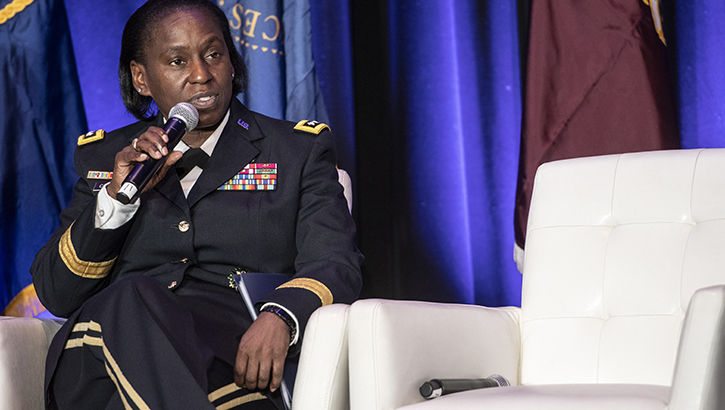DHA Director: Technology Helps to “Meet the Patients Where They Are”
 Defense Health Agency Director Lt. Gen. Telita Crosland took the podium at the 2023 AMSUS Annual Meeting, sharing her vision for DHA’s future. The meeting, held from Feb. 13-16 in National Harbor, Maryland, brought together top minds in military, public, veteran, and global health. (Photo by: Robert Hammer)
Defense Health Agency Director Lt. Gen. Telita Crosland took the podium at the 2023 AMSUS Annual Meeting, sharing her vision for DHA’s future. The meeting, held from Feb. 13-16 in National Harbor, Maryland, brought together top minds in military, public, veteran, and global health. (Photo by: Robert Hammer)
U.S. Army Lt. Gen. Telita Crosland, director of the Defense Health Agency, shared her vision for DHA’s future, her priorities, and the growing role of technology during remarks presented at the annual meeting of AMSUS, the society for federal health professionals, held in National Harbor, Maryland. The theme of the AMSUS meeting was “Healthcare Collaboration: Meeting the Challenges of Today and Tomorrow.”
“The first priority of the MHS is to keep the force healthy and ready to get out the door,” said Crosland. “The second priority is to keep the medical force trained and ready to get out the door with them. The third priority is for the agency to run platforms to receive casualties, and the fourth priority is the benefit.”
Crosland joined the Acting Assistant Secretary of Defense for Health Affairs, the surgeons general of the U.S. Army, U.S. Navy, and U.S. Air Force, the Joint Staff Surgeon, and the president of the Uniformed Services University of the Health Sciences in a plenary discussion highlighting the mission of the Military Health System and the future of military medicine.
Crosland explained that the MHS does not exist apart from the broader U.S. health care system.
“We’re part of it,” she said. “Our future is dependent on understanding that system. Partnering where it makes sense. Building and sustaining our own capacity where we must.”
Crosland joined her colleagues in emphasizing the unique nature of military medicine, both the challenges and opportunities.
“Whether that’s at sea, in small unit operations, in disaster assistance or humanitarian operations, we don’t have the luxury of waiting to see what others do,” said Crosland. “We need to be leaders in exploring how to care for our people using technology that is available today, and that can be scaled tomorrow.”
Crosland, who became DHA’s fourth director in its 10-year history on Jan. 3, 2023, also addressed the ongoing digital transformation at the DHA.
 Defense Health Agency Director Lt. Gen. Crosland offered insight into a range of health care topics at a question-and-answer session at the 2023 AMSUS Annual Meeting. (Photo by: Robert Hammer)
Defense Health Agency Director Lt. Gen. Crosland offered insight into a range of health care topics at a question-and-answer session at the 2023 AMSUS Annual Meeting. (Photo by: Robert Hammer)
“We need to think more broadly and more boldly about what is possible,” she said. “Not in a 10-year, over-the-horizon way. But today—what can we achieve in 2023 ... no other health enterprise in the world has as much at stake as the MHS in a digital transformation to prepare for our future challenges.”
The rollout of the MHS GENESIS electronic health record system exemplifies the digital revolution already underway at DHA. Crosland noted that while MHS GENESIS deployment is expected to be complete by the end of 2023, it represents a beginning—not an end of DHA’s digital evolution—laying the groundwork for what comes next.
She spoke about a “disciplined approach to innovation that is scalable and that we can do quickly. That will be my focus of the first year: technology that is right for leveraging across the entire system.”
New approaches to health care delivery are underway as well, especially virtual health care delivery tools that allow patients to receive care remotely.
“The pandemic has shown, and patients have embraced, that if you can’t bring the patient to the hospital, we need to bring the hospital to the patient,” said Crosland, a family medicine physician and graduate of the Uniformed Services University of the Health Sciences.
She shared how technology could continue to enhance the future of health care and offered a look ahead for the federal medical professionals attending the conference.
“Our vision of the future is one where physicians, nurses and medics and corpsmen are liberated by technology rather than burdened by it; a vision where the burden of monitoring and entering data for providers and patients is offloaded on devices and services that are connected, interoperable, and—through the use of AI—smart,” Crosland continued. “We are going to meet the patients where they are. Anytime. Anywhere. Always.”
In reference to her new role as director, Crosland discussed how she wants the DHA to evolve under her leadership.
“We’ve got to, as an organization, adopt a culture that embraces innovation in a disciplined way,” said Crosland. “My first step is to see all the great things out there that are going on, to move us as an organization [and] to move us from brick and mortar to a digitalized organization … I am so grateful for this opportunity to lead the agency in addressing the urgent needs of today.”